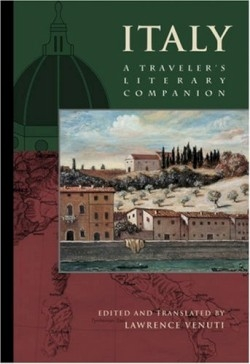Italy
A Traveler's Literary Companion
Images of Italy one wouldn’t encounter in travel guides are presented in this collection of short stories, each describing a different city or region while not making the location the focal point of the story.
For instance, in “The Other Family,” by poet-novelist-playwright Dacia Maraini, the protagonist jets between Milan and Rome, tossing around disparaging remarks about the other city to inhabitants of the city she’s in. Her daily life-work, school for the children, going to the cinema, watching television, parenting-gives a better glimpse at Milanese or Roman life than a regular guidebook ever could. It’s like looking through someone’s front window at night as you drive by in the dark. It’s a view most tourists never get.
The editor has previously written several books about translation studies and has edited and translated novels and poetry collections. In his preface to this volume, he says that he strived for the “insider’s view,” using geography as the most crucial criteria. He’s grouped the stories by locale, moving from north to south. The map at the beginning of the book is very useful.
One of the Tuscany selections, “A Geographical Error,” by Romano Bilenchi, involves a student who leaves his home town to study and finds that everyone at the university thinks he’s from the Maremma. Apparently, the Maremma isn’t a good place to be from and he’s never considered his home town to be part of it, but he can’t convince anyone else that it’s not. He gets in numerous altercations in classes and social situations, but only succeeds in sinking himself in deeper. This simple story, with its tenacious student as the guide, gives readers insight into not only university life in Italy, but rural life as well, and stereotypes that are fostered everywhere.
The stories were written between 1938 and 2000. Each story lists the year it was published, and offers a note about the author that includes a brief biography and a list of other works. Many have been translated into English for the first time. There is a bibliography of “Other Readings” as well as a note about the translator.
The stories include characters from all walks of life-dressmakers, students, lawyers, retirees, city dwellers, country dwellers, travelers. Italy itself, slyly, ends up being the most important character. The descriptions of Venice in “Built to Kill,” by Tiziano Scarpa, take one’s breath away almost as much as the story’s surprise ending.
Disclosure: This article is not an endorsement, but a review. The publisher of this book provided free copies of the book to have their book reviewed by a professional reviewer. No fee was paid by the publisher for this review. Foreword Reviews only recommends books that we love. Foreword Magazine, Inc. is disclosing this in accordance with the Federal Trade Commission’s 16 CFR, Part 255.

